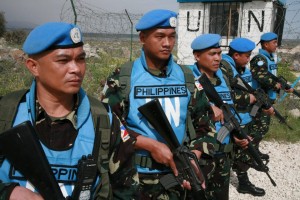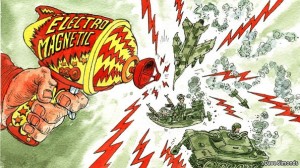 The recent crisis faced by Philippine Peacekeepers in the United Nations Disengagement Observer Force (UNDOF) highlights the fluid dynamics in alliances and the unexpected consequences that have precipitated in the wake of the Syrian Civil War.
The recent crisis faced by Philippine Peacekeepers in the United Nations Disengagement Observer Force (UNDOF) highlights the fluid dynamics in alliances and the unexpected consequences that have precipitated in the wake of the Syrian Civil War.
On the morning of August 28th, approximately 75 Philippine Army troops of the 7th Contingent to UNDOF were surrounded by militant forces, some later identified as Al-Nusra Front fighters, and were ordered to surrender their arms. The Anti-Government Fighters focused their siege against strategic UN positions including Al-Quinaytirah, the only crossing over the Golan Heights. The situation was exacerbated by the earlier capture of approximately 44 UN soldiers from Fiji manning posts on the Northern sector of the ceasefire zone. The rebels attacking the Philippine positions initially sent an English-speaking Fiji soldier to relay their surrender demands.
The peacekeepers, split into two units spread across the Filipino sector of responsibility, both refused the call to disarm. A fire-fight later ensued at their positions in Ar-Ruwayhinah, located in the southern portion of the Heights. Despite being armed with only rifles and squad weapons, the Philippine unit was highly experienced – most of the UNDOF contingent belong to the 80th Infantry Battalion – which came fresh off anti-communist combat operations in Mindoro and run through a preparatory workup before deploying in the Golan. The militants arrived in technicals armed with anti-aircraft guns and besieged UNDOF Oupost 68 for several hours before being driven off. At one point, the rebel pick-up trucks started ramming the outpost gate to overrun the defenders and subjected the troops to mortar fire.
Some of the encircled troopers were eventually relieved and withdrawn to more secure positions by a combined Irish-Filipino Mobile Reaction Force equipped with armored personnel carriers from Camp Faroar on the Syrian side of the Heights. Outpost 68 was able to walk out on their own terms after a lull in the fighting and re-consolidated at Mission HQ in Camp Ziouani near the Israeli border. What was notable is that the Al-Assad Syrian Army fired artillery rounds during the Outpost 68 firefight to help suppress the rebel assault. This may be a result of back-channel discussions stemming from then Philippine Secretary of National Defense Gilberto Teodoro’s mission to Damascus as early as 2009, when the Manila started contributing troops to the UN mission. But equally likely is the well-established “Cooperation and Coordination” aspect of UNDOF with the warring parties, which was finely-honed when the Mission was first established in the mid-1970s. UNDOF Command closely communicates at an operational level with both Israeli Defense Force and Assad’s Syrian Army through liaisons. Additionally, this is a strong indicator that the Assad regime is not as unstable as the popular media narrative would indicate. The ability to quickly and effectively deliver indirect fire into the Area of Separation speaks to the existence of intact and professional Syrian Army elements despite the widespread Civil War.
This is not the first time Philippine forces in UNDOF have been under fire. In 2011, approximately 21 troopers and civilian workers were taken hostage but later freed without incident, and another soldier wounded by shellfire during the same year.
The assistance of the Syrian Government during this crisis is in direct contrast to current Western foreign policy, which seeks the unconditional removal of Assad’s regime. Collectively, all the stakeholders in the localized area of the Golan recognize the greater threat that the more militant spectrum of the Syrian rebellion represents, and can cooperate when necessary to achieve the common goal of maintaining stability within the area.
The dynamics of individual Peacekeeping Missions are also subject to the aspects of operational realities and unexpected consequences on the ground.
In the Outpost 68 firefight, the Anti-Government fighters were reportedly adamant about the Philippine troops surrendering their weapons before acceding to a cease-fire, as a matter of honor. It is likely that the rebels also saw this as a means of expanding their Table of Equipment. Equally on the same point, as well as for more practical reasons, the Philippine troops refused to turn over their weapons, most of which was newly issued and the latest in terms of ordnance available to the country’s Armed Forces. The firefight may have been inevitable from a tactical viewpoint, but the supposed demand by UNDOF Mission Commander Lt. General Iqbal Singha of India that the Filipinos surrender to ensure the Fijians’ safety by “stacking arms” prompted a call for investigation by Armed Forces of the Philippines (AFP) Chief of Staff Gregorio Catapang Jr. If the allegations have merit, it would be highly ironic given the UNDOF I-C’s very comments to the contingent during the October 2013 UN Day Parade that “Your job is to carry out your peacekeeping tasks and my job is to ensure your security.”
The back-channel discussions between SND Teodoro and the Assad government reflects multi-polar realpolitik. While the Philippines is generally seen as a supporter and beneficiary of US strategy and foreign policy in the Pacific, there is a small wealth of political capital that the Asian nation can use in other regions, where Filipinos are seen as a highly reliable source of skilled and unskilled labor, and generally not viewed as an enabler or facilitator of an increasingly divisive and unclear U.S. diplomatic approach. Leveraging such capital at the right time and the right crisis can result in short-term gains without materially compromising key allies’ existing relationships nor overtly undermining their initiatives.
Another long-standing issue of concern is the inadequate force-protection capabilities of the peacekeepers themselves. In 2013, Philippine Secretary of Foreign Affairs Albert del Rosario met with UN officials to air concerns regarding relative troop strength in the Heights and to ensure that the necessary equipment for the “protection and defense of Filipino troops and other UNDOF” were procured by October of that year. The dilemma of adequately arming peacekeepers is well-known and understood, but given the circumstances of the raging Civil War, it is likely that the UN forces will continue to encounter more violent and zealous factions involved in the turmoil, and must make sound decisions regarding practical limits of the “Minimum Use of Force” directive. A larger consideration must be made to enhancing force-protection measures while remaining true to the “peacekeeping” charter. This particular crisis pointed to several shortcomings; such as weapons inadequate to the higher threat level, better intelligence and monitoring of movement within the Area of Separation and a consistent Rules of Engagement (one unit fought, the other did not) as well as contingency and scenario planning (one unit was relieved, the other had to egress independently with no support). Otherwise the UN Peacekeeping Force will only perpetuate and not prevent conflicts, as blue-helmets are taken hostage for their political value and their equipment seized to further malicious actor goals.
As a corollary, there’s something to be said about gauging the quality of forces a nation contributes to UN Security Missions. Had it been a less experienced Philippine unit in place than the already-blooded 80th Infantry Battalion, the outcome might have been very different. It is undoubtedly helpful that the troops had already “seen the elephant” in counter-insurgency operations when the militants started firing.
As a direct result of the deteriorating conditions in the Syrian Civil War, the Philippine Government has announced a complete withdrawal of forces until further notice to both the UNDOF and the UNMIL mission in Liberia, the latter due to the increased health risk of the Ebola outbreak. The Philippines had been contributing personnel to both missions since 2009 and 2003 respectively, and was the nation-in-command for UNDOF in 2012. This doesn’t bode well for many UN security missions – if nations start to withdraw because the global organization cannot effectively manage the numerous efforts underway (at last count 17 Missions world-wide and involving over 100,000 personnel), the spread of a regional crisis progressively engulfing larger portions of the globe could become a grim reality.
Juramentado is the pseudonym for Armando J. Heredia, a civilian observer of naval affairs. He is an IT Risk and Information Security practitioner, with a background in the defense and financial services industries. The views and opinions expressed in this article are those of the author, and do not necessarily represent the views of, and should not be attributed to, any particular nation’s government or related agency.




 Get ready to hear two Asia Pacific analysts share their views on Japan’s remilitarisation and its implications for regional security.
Get ready to hear two Asia Pacific analysts share their views on Japan’s remilitarisation and its implications for regional security. 

